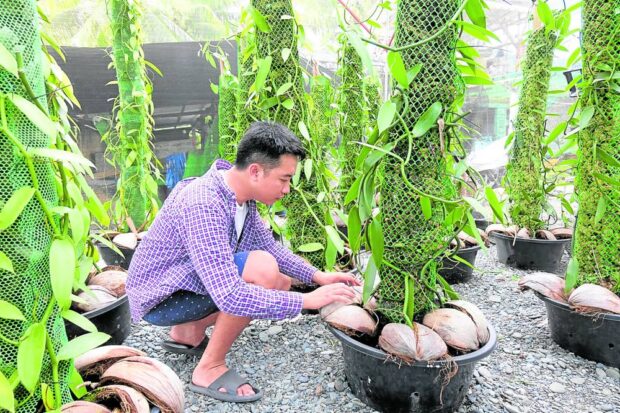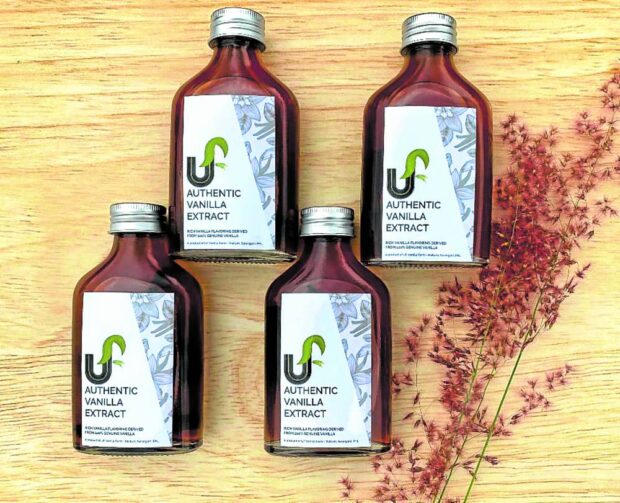Vanilla farming takes root in Sarangani

TENDER CARE | Melvin Awid checks on his vanilla plants at his demonstration farm in Maitum, Sarangani. The plant has not yet been grown on a commercial scale in the country but Awid, a former seafarer, is hoping that he and local farmers will be able to help produce bigger volumes of this spice to fill in the demand. (Photo by BONG S. SARMIENTO / Inquirer Mindanao)
MAITUM, Sarangani, Philippines — In this bucolic coastal town where swathes of rice, corn, banana, cacao and coconut farms dominate the agricultural landscape, a millennial has taken a great leap of faith by growing vanilla on a commercial scale in this humid region.
In his globe-trotting job as a seafarer, Melvin Awid, 29, stumbled on the prospects of vanilla during a brief stopover in Madagascar, an island country off the southeastern coast of the African continent, just before the COVID-19 pandemic disrupted the global order in early 2020. Madagascar is the world’s largest producer of vanilla.
“While anchored, I smelled the scent of vanilla from this laborer. It was so good that I got curious. Fortunately, he was kind and walked me through the basics of the vanilla plant,” he told the Inquirer.
“Vanilla is a versatile crop. It can be used in food, beverage, and cosmetics,” Awid noted.
Next to saffron, vanilla is the second most expensive spice traded globally. According to Zion Market Research, the global market of vanilla accounted for $510 million in 2018 and is expected to grow to $735 million by 2026.
Article continues after this advertisementIn a half-hectare plot within the family’s 5-hectare farm in Barangay Kalaneg here, Awid successfully cultivated at least 500 vanilla plants from 25 saplings when he started the venture in December 2020.
Article continues after this advertisementHis vanilla plants, a type of vining orchid, crawled on madre de cacao trees that he also planted then. He propagated the plant through cuttings.
Awid graduated from the Davao Merchant Marine Academy of Southern Philippines. From an ordinary seafarer doing cleaning jobs, he rose from the ranks to become a merchant officer, serving as a safety officer and doing administrative work.
After five years, he was already earning a six-digit salary when he quit the job to pursue vanilla farming in his quaint hometown, about three hours away from General Santos City, the economic center of Soccsksargen (South Cotabato, Cotabato, Sultan Kudarat, Sarangani, and General Santos) region.

Awid stumbled on the prospects of vanilla during a brief stopover in Madagascar, the world’s largest producer of vanilla. (Photo by BONG S. SARMIENTO / Inquirer Mindanao)
Experiment
While still doing seafaring work, Awid successfully propagated vanilla aboard a ship, giving him hope it can also do well on land.
He had proven himself right. After three years of vanilla farming, he is now producing pure vanilla extract for food flavoring enhancement and selling it to five-star hotels and high-end restaurants in major cities of the country through UF Vanilla Farm.
Recently, Awid’s venture gained the attention of the Department of Agriculture and the municipal and provincial governments, which vowed to support his project. Due to the growing interest in vanilla farming, Awid has established a demonstration facility just outside their house where he entertains visitors.
Compared to the cheap synthetic vanilla flavoring products readily available in the market, which can be bought for P110 per liter in online shops, Awid’s pure vanilla extract sells for P3,500 for the 350-milliliter bottle, or P10 per ml.
Way out of poverty
There is a big market for nonsynthetic vanilla in the domestic and global markets, he said, noting that his vision is to make Sarangani the “Vanilla Capital of the Philippines.”
Sarangani Gov. Rogelio Pacquiao and the Office of the Provincial Agriculturist had promised support for Awid’s project, committing to allot a budget to disperse vanilla cuttings to farmers.
Sarangani is among the top 10 poorest provinces in the country and vanilla cultivation could offer a way out by getting indigenous peoples and out-of-school youth to plant the crop, Awid said.
Vanilla thrives well in shaded areas and does not need plenty of water, he noted. Hence letting the plant crawl in madre de cacao trees, which is easy to propagate, is a good and cheap farming practice, he added.
Awid said that from planting, vanilla can flower in three years with one plant producing at least 2.5 kilograms of pods, which when processed can yield 10 liters of vanilla extract for food flavoring, or 5 ml to 25 ml of pure essential oil.
A vanilla plant has a productive life of 10 to 15 years.
In a time when children of farmers have been leaning toward white-collar jobs and tending to shy away from farming due to its low earnings, Awid’s career shift from a lucrative job as a seafarer may be frowned upon.
“Farming is not a mediocre profession. In the case of vanilla, there’s a big opportunity from it,” he stressed, saying once his plants reach their full potential, he can earn even bigger than his stint on board sea vessels.
“While earning from farming, I also have the precious luxury of owning my time,” Awid beamed.

HIGH VALUE Vanilla extract produced by Melvin Awid from his farm sells for P3,500 per 350 milliliter bottle.
Looking for suppliers
According to him, a potential client from the United States is looking for suppliers of pure vanilla extracts who can produce a volume of at least 100,000 tons per year.
Some 50 ha to 100 ha of vanilla farm can produce such volume, Awid said, urging farmers in Sarangani and neighboring provinces to shift to vanilla farming.
“With more farmers planting vanilla, we are looking to consolidate our production so we can meet the demand of big clients,” he said.
Admittedly, vanilla farming is relatively new in the Philippines, with few farms in Luzon cultivating the crop so far.
By taking a leap of faith, Awid is hoping he can trigger the interest of other farmers or even small backyard owners, beginning in his province, to start farming vanilla.